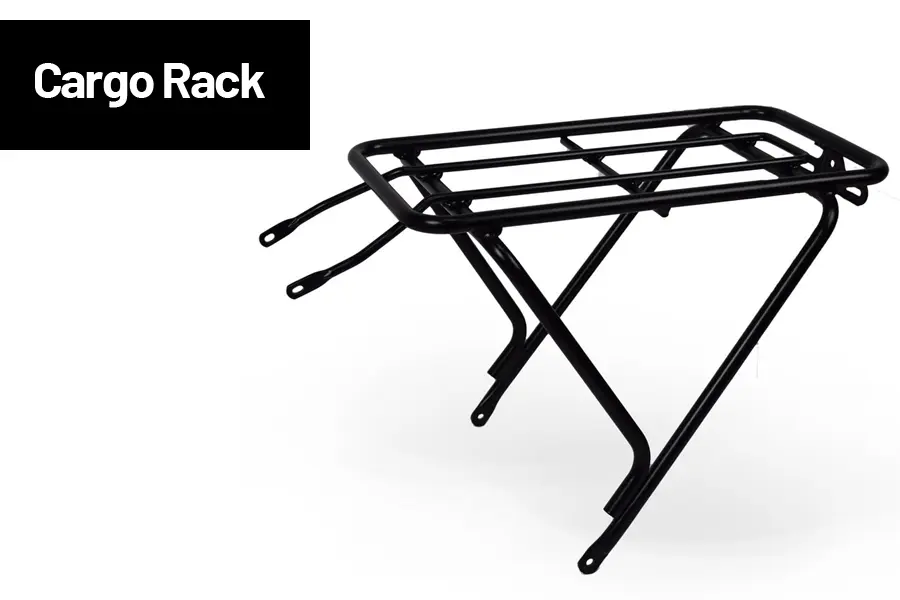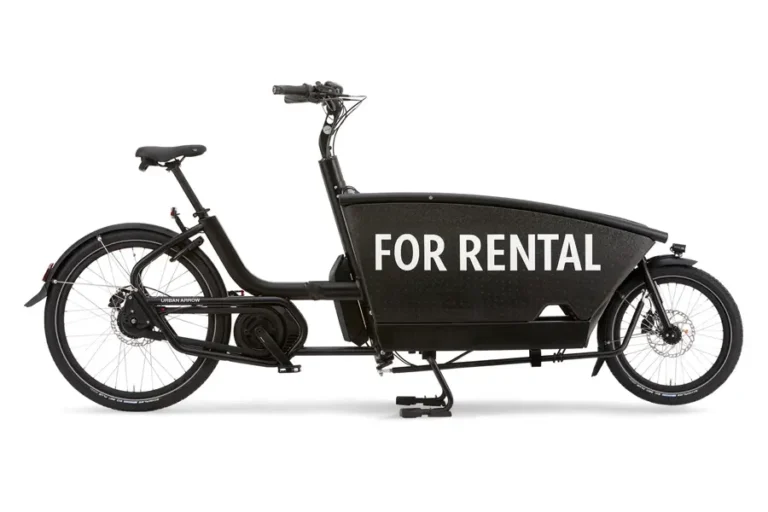Compreender o design, a função e como escolher o bastidor certo para as suas necessidades
Como um fabricante de bicicletas de carga, nós da Regen são frequentemente questionados: "O suporte de carga é essencial?" ou "Posso transportar carga extra sem uma caixa, apenas um suporte?" A verdade é que os porta-cargas são um dos componentes mais subestimados mas essenciais numa mota de utilidade pública.
Neste artigo, vamos explicar tudo o que precisa de saber sobre os porta-bagagens - o que são, como funcionam, que tipos existem e como selecionar o mais adequado, dependendo das suas necessidades de transporte. Quer esteja a transportar mercadorias, a fixar sacos de entrega ou a adicionar cadeiras de criança, o suporte de carga certo transforma a sua bicicleta eléctrica numa máquina verdadeiramente polivalente.
O que é um suporte de carga na Cargo Bike?
UM porta-cargas é um estrutura de suporte de carga montado sobre a roda traseira ou dianteira de uma bicicleta - particularmente comum em bicicletas de carga longtail e utilitárias. Foi concebido para suportar peso adicional tais como:
- Caixas e caixotes
- Cadeiras para crianças
- Sacos de supermercado ou contentores de entrega
- Alforges ou sacos macios
- Kits de ferramentas ou equipamento de reparação
Na sua essência, é uma plataforma estável para soluções modulares de transportepermitindo-lhe flexibilidade no que e como transportar.
Na Regen, os nossos porta-cargas traseiros são soldada no quadro em bicicletas longtail ou montadas com suportes reforçados em trikes de carga frontal e Long Johns. Concebemos porta-bagagens com Normas de carga DIN EN 17860 garantindo uma capacidade de carga segura e certificada para utilizadores comerciais e privados.
✅ Definição: Um porta-cargas é uma estrutura metálica de suporte (normalmente em alumínio ou aço) fixada ao quadro, concebida para suportar o peso adicional da carga independentemente do peso do condutor.
Porque é que um suporte de carga é importante no design de uma bicicleta de carga
Numa bicicleta eléctrica normal, a ausência de um suporte pode ser apenas inconveniente. Numa bicicleta de carga, pode significar incompatibilidade com casos de utilização essenciais. Eis a razão:
| Benefício | Descrição |
|---|---|
| Aumenta a capacidade de carga | O transporte numa prateleira liberta a caixa de carga dianteira para objectos maiores ou passageiros. |
| Configuração flexível | É possível montar alforges, cadeiras de criança ou sacos de entrega isolados. |
| Distribuição do peso | Ajuda a equilibrar a carga entre a frente e a traseira, melhorando o manuseamento. |
| Prontidão da frota | Permite trocas rápidas de equipamento para uma utilização polivalente. |
| Conformidade com as normas | Muitos contratos de entrega urbana exigem sistemas de carga seguros e montados em prateleiras. |
É frequente equiparmos as nossas bicicletas de carga com porta-bagagens traseiro integrado que suportam até 60-100 kg, consoante o modelo. Alguns clientes chegam mesmo a personalizar as estantes para painéis solares ou painéis publicitários personalizados.
💡 Pretende atualizar a sua configuração de entrega? Saiba como as caixas de carga modulares funcionam com os nossos sistemas de estantes →
Tipos de porta-cargas em bicicletas de carga
Vamos explorar os modelos de porta-cargas mais comuns encontrados nas modernas bicicletas eléctricas de carga, incluindo a nossa própria linha Regen.
1. Porta-cargas traseiro (estilo Longtail)
- Integrado no quadro ou fixado no espigão do selim e nos suportes do dropout
- Ideal para cargas pesadas, cadeiras de criança ou duas malas de viagem
- Suporta normalmente 40-100 kg
- Compatível com bancos Thule Yepp, alforges Ortlieb ou módulos de entrega personalizados
2. Porta-cargas dianteiro (montagem em porta-cargas ou garfo utilitário)
- Montado na coroa da forquilha ou no tubo da cabeça
- Mantém a carga no campo de visão do condutor
- Suporta até 25-40 kg
- Popular para entrega de alimentos, kits de ferramentas ou sacos de escritório
3. Estante de plataforma dupla (dianteira + traseira)
- Permite uma carga equilibrada em ambas as extremidades
- Encontrado em bicicletas de entrega e estafetas de alto desempenho
- O suporte frontal é frequentemente fixo (não gira com o guiador), melhorando a estabilidade
4. Rack integrado + caixa híbrida
- Combina na perfeição a estrutura da estante com o sistema de caixas fechadas
- Utilizado em caixas de carga fechadas ou isoladas (por exemplo, caixas térmicas de entrega do Regen)
- Concebida com calhas ou pontos de montagem de encaixe para modularidade
Principais caraterísticas a considerar
Ao selecionar ou personalizar um suporte de carga, recomendamos sempre que avalie o seguinte:
| Recurso | Porque é que é importante |
|---|---|
| Material | O alumínio é leve e resistente à corrosão. O aço é mais forte mas mais pesado. |
| Tipo de montagem | As estantes aparafusadas são flexíveis. As estantes integradas são mais resistentes mas fixas. |
| Compatibilidade | Verificar as dimensões e os pontos de fixação (suportes roscados M5/M6, interfaces para cadeiras de criança). |
| Capacidade de peso | Certifique-se de que satisfaz as suas necessidades em termos de carga, acrescidas de uma margem de segurança de 20%. |
| Caraterísticas de estabilidade | Algumas prateleiras incluem calhas laterais, ganchos de bungee ou iluminação integrada. |
Na Regen, testamos todos os porta-cargas sob vibrações simuladas em estradas, cargas de choque e stress ambiental. As nossas estantes são tratadas com revestimento ED de dupla camada + revestimento em pó para uma durabilidade em condições climatéricas extremas.
Precisa de ajuda para escolher a configuração correta das grades traseiras para a sua frota? Contactar a nossa equipa de engenharia →
Porta-cargas vs. Caixas de carga: Quando utilizar qual?
Esta é uma pergunta comum dos novos compradores de bicicletas de carga. Eis um resumo rápido:
| Caso de uso | Melhor opção |
|---|---|
| Transporte de crianças | Grade traseira + cadeira de criança com apoios para os pés e arnês |
| Entrega comercial | Caixa frontal + porta-bagagens traseiro para sacos ou caixas modulares |
| Viagens de supermercado | Caixas de transporte no suporte ou cesto frontal aberto |
| Transporte de ferramentas/equipamentos | Grade frontal com ganchos para fixação de cintos |
A vantagem de um porta-cargas é versatilidade. Enquanto as caixas são ideais para o volume, as prateleiras oferecem um carregamento rápido e uma melhor aerodinâmica quando circulam vazias.
Dicas de segurança para porta-cargas
Apesar de os porta-cargas parecerem simples, a segurança continua a ser uma prioridade. Eis algumas dicas importantes que partilhamos com os nossos clientes:
- Distribuir uniformemente o peso da esquerda para a direita para evitar inclinações
- Utilizar correias de catraca ou cordões elásticos para fixar firmemente a carga
- Verificar regularmente os parafusos de fixaçãoespecialmente após cargas pesadas
- Não exceder o peso nominalespecialmente em quadros suspensos
- Evitar cantos afiados ou contacto de metal com metal que podem danificar o suporte ou o quadro da bicicleta
Procura uma estante que não faça barulho, mesmo com 40 kg em estradas de pedra? Descubra as nossas bicicletas de carga testadas em termos de vibração
A nossa filosofia de porta-cargas em Regen
Não tratamos o porta-bagagens como uma reflexão tardia. Em vez disso, é uma componente principal do valor utilitário da bicicleta de carga.
Quer estejamos a conceber para o transporte de famílias, para a entrega de correio ou para a logística de restaurantes, integramos a conceção de estantes logo no início do nosso processo de I&D. As nossas estantes são:
- Testado para além das normas de carga EN
- Modular e substituível para utilização a longo prazo
- Soldado ou aparafusado consoante o modeloequilíbrio entre força e flexibilidade
Combinado com a nossa fábrica de quadros interna e a fábrica de montagem de 6600㎡ da UE, podemos entregar bicicletas de carga prontas para carregamento e utilização no mundo real.
Considerações finais
Uma bicicleta de carga sem um porta-cargas adequado é apenas meio funcional. Quer se trate de um utilizador profissional que procura maximizar a eficiência ou de um pai que transporta as compras e as crianças, o porta-cargas desempenha um papel central na o seu desempenho diário, segurança e satisfação.
Nós da Regen incentivamos todos os motociclistas e compradores a ver o suporte não como um acessório menor, mas como um plataforma de adaptabilidade. É o ponto de ligação entre a sua bicicleta e as suas necessidades no mundo real.
Lista de referências
- Federação Europeia de Ciclistas (FEC). (2023). Bicicletas de carga e logística urbana: Política e Infra-estruturas. Recuperado de https://ecf.com
- Comité Europeu de Normalização. (2023). EN 17860-1:2023 Bicicletas - Bicicletas de carga - Requisitos de segurança e métodos de ensaio para bicicletas de carga assistidas eletricamente (EPAC). Bruxelas: CEN.
- Bosch eBike Systems. (n.d.). Ensaios de carga e resistência para acessórios para eBike. Obtido em https://www.bosch-ebike.com
- Grupo Thule. (n.d.). Thule Yepp Maxi - Compatibilidade com os porta-bicicletas traseiros. Recuperado de https://www.thule.com







